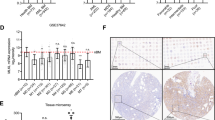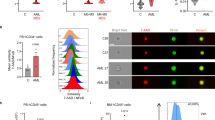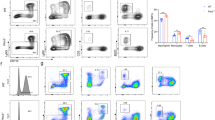Abstract
Mutations in the granulocyte colony-stimulating factor receptor (G-CSF-R) gene leading to a truncated protein have been identified in a cohort of neutropenia patients highly predisposed to acute myeloid leukemia. Such mutations act in a dominant manner resulting in hyperproliferation but impaired differentiation in response to G-CSF. This is due, at least in part, to defective internalization and loss of binding sites for several negative regulators, leading to sustained receptor activation. However, those signaling pathways responsible for mediating the hyperproliferative function have remained unclear. In this study, analysis of an additional G-CSF-R mutant confirmed the importance of residues downstream of Box 2 as important contributors to the sustained proliferation. However, maximal proliferation correlated with the ability to robustly activate signal transducer and activator of transcription (STAT) 5 in a sustained manner, whereas co-expression of dominant-negative STAT5, but not dominant-negative STAT3, was able to inhibit G-CSF-stimulated proliferation from a truncated receptor. Furthermore, a Janus kinase (JAK) inhibitor also strongly reduced the proliferative response, whereas inhibitors of mitogen-activated protein kinase/extracellular signal-regulated kinase kinase (MEK) or phosphatidylinositol (PI) 3-kinase reduced proliferation to a lesser degree. These data suggest that sustained JAK2/STAT5 activation is a major contributor to the hyperproliferative function of truncated G-CSF receptors, with pathways involving MEK and PI 3-kinase playing a reduced role.
This is a preview of subscription content, access via your institution
Access options
Subscribe to this journal
Receive 12 print issues and online access
$259.00 per year
only $21.58 per issue
Buy this article
- Purchase on Springer Link
- Instant access to full article PDF
Prices may be subject to local taxes which are calculated during checkout





Similar content being viewed by others
References
van de Geijn GJ, Aarts LHJ, Erkeland SJ, Prasher JM, Touw IP . Granulocyte colony-stimulating factor and its receptor in normal hematopoietic cell development and myeloid disease. Rev Physiol Biochem Pharmacol 2003; 149: 53–71.
de Koning JP, Schelen AM, Dong F, van Buitenen C, Burgering BM, Bos JL et al. Specific involvement of tyrosine 764 of human granulocyte colony-stimulating factor receptor in signal transduction mediated by p145/Shc/GRB2 or p90/GRB2 complexes. Blood 1996; 87: 132–140.
Ward AC, Smith L, de Koning JP, van Aesch Y, Touw IP . Multiple signals mediate proliferation, differentiation and survival from the granulocyte colony-stimulating factor receptor in myeloid 32D cells. J Biol Chem 1999; 274: 14956–14962.
Tian S-S, Lamb P, Seidel HM, Stein RB, Rosen J . Rapid activation of the STAT3 transcription factor by granulocyte colony-stimulating factor. Blood 1994; 84: 1760–1764.
Nicholson SE, Starr R, Novak U, Hilton DJ, Layton JE . Tyrosine residues in the granulocyte colony-stimulating receptor (G-CSF-R) mediate G-CSF-induced differentiation of murine myeloid leukemic (M1) cells. J Biol Chem 1996; 271: 26947–26953.
de Koning JP, Dong F, Smith L, Schelen AM, Barge RM, van der Plas DC et al. The membrane-distal cytoplasmic region of human granulocyte colony-stimulating factor receptor is required for STAT3 but not STAT1 homodimer formation. Blood 1996; 87: 1335–1342.
Shimoda K, Feng J, Murakami H, Nagata S, Watling D, Rogers NC et al. Jak1 plays an essential role for receptor phosphorylation and Stat activation in response to granulocyte colony-stimulating factor. Blood 1997; 90: 597–604.
Ward AC, Hermans MHA, Smith L, van Aesch YM, Schelen AM, Antonissen C et al. Tyrosine-dependent and independent mechanisms of STAT3 activation by the human granulocyte colony-stimulating factor (G-CSF) receptor are differentially utilized depending on G-CSF concentration. Blood 1999; 93: 113–124.
Bashey A, Healy L, Marshall CJ . Proliferative but not nonproliferative responses to granulocyte-colony stimulating factor are associated with rapid activation of the p21ras/MAP kinase signalling pathway. Blood 1994; 83: 949–957.
Barge RM, de Koning JP, Pouwels K, Dong F, Löwenberg B, Touw IP . Tryptophan 650 of human granulocyte colony-stimulating factor (G-CSF) receptor, implicated in the activation of JAK2, is also required for G-CSF-mediated activation of signaling complexes of the p21ras route. Blood 1996; 87: 2148–2153.
de Koning JP, Soede-Bobok AA, Schelen AM, Smith L, van Leeuwen D, Santini V et al. Proliferation signaling and activation of Shc, p21Ras and Myc via tyrosine 764 of human granulocyte colony-stimulating factor receptor. Blood 1998; 91: 1924–1933.
Rausch O, Marshall CJ . Cooperation of p38 and extracellular signal-regulated kinase mitogen-activated protein kinase pathways during granulocyte colony-stimulating factor-induced hemopoietic cell proliferation. J Biol Chem 1999; 274: 4096–4105.
Akbarzadeh S, Ward AC, McPhee DO, Alexander WS, Lieschke GJ, Layton JE . Tyrosine residues of the granulocyte colony-stimulating factor receptor transmit proliferation and differentiation signals in murine bone marrow cells. Blood 2002; 99: 879–887.
Hunter MG, Avalos BR . Phosphatidylinositol 3′-kinase and SH2-containing inositol phosphatase (SHIP) are recruited by distinct positive and negative growth-regulatory domains in the granulocyte colony-stimulating factor receptor. J Immunol 1998; 160: 4979–4987.
Hunter MG, Avalos BR . Granulocyte colony-stimulating factor receptor mutations in severe congenital neutropenia transforming to acute myeloid leukemia confer resistance to apoptosis and enhance cell survival. Blood 2000; 95: 2132–2137.
Dong F, Larner AC . Activation of Akt kinase by granulocyte colony-stimulating factor (G-CSF): evidence for the role of a tyrosine kinase activity distinct from the Janus kinases. Blood 2000; 95: 1656–1662.
Dong F, van Buitenen C, Pouwels K, Hoefsloot LH, Löwenberg B, Touw IP . Distinct cytoplasmic regions of the human granulocyte colony-stimulating factor receptor involved in induction of proliferation and maturation. Mol Cell Biol 1993; 13: 7774–7781.
Dong F, Hoefsloot LH, Schelen AM, Broeders CA, Meijer Y, Veerman AJ et al. Identification of a nonsense mutation in the granulocyte-colony-stimulating factor receptor in severe congenital neutropenia. Proc Natl Acad Sci USA 1994; 91: 4480–4484.
Dong F, Brynes RK, Tidow N, Welte K, Löwenberg B, Touw IP . Mutations in the gene for the granulocyte colony-stimulating-factor receptor in patients with acute myeloid leukemia preceded by severe congenital neutropenia. N Engl J Med 1995; 333: 487–493.
Dong F, Dale DC, Bonilla MA, Freedman M, Fasth A, Neijens HJ et al. Mutations in the granulocyte colony-stimulating factor receptor gene in patients with severe congenital neutropenia. Leukemia 1997; 11: 120–125.
McLemore ML, Poursine-Laurent J, Link DC . Increased granulocyte colony-stimulating factor responsiveness but normal resting granulopoiesis in mice carrying a targeted granulocyte colony-stimulating factor receptor mutation derived from a patient with severe congenital neutropenia. J Clin Invest 1998; 102: 483–492.
Hermans MHA, Ward AC, Antonissen C, Karis A, Lowenberg B, Touw IP . Perturbed granulopoiesis in mice with a targeted mutation in the granulocyte colony-stimulating factor receptor gene associated with severe chronic neutropenia. Blood 1998; 92: 32–39.
Dale DC, Person RE, Bolyard AA, Aprikyan AG, Bos C, Bonilla MA et al. Mutations in the gene encoding neutrophil elastase in congenital and cyclic neutropenia. Blood 2000; 96: 2317–2322.
Hermans MH, Touw IP . Significance of neutrophil elastase mutations versus G-CSF receptor mutations for leukemic progression of congenital neutropenia. Blood 2001; 97: 2185–2186.
Mitsui T, Watanabe S, Taniguchi Y, Hanada S, Ebihara Y, Sato T et al. Impaired neutrophil maturation in truncated murine G-CSF receptor transgenic mice. Blood 2003; 101: 2990–2995.
Hermans MHA, Antonissen C, Ward AC, Mayen AEM, Ploemacher RE, Touw IP . Sustained receptor activation and hyperproliferation in response to granulocyte colony-stimulating factor (G-CSF) in mice with a severe congenital neutropenia/acute myeloid leukemia-derived mutation in the G-CSF receptor gene. J Exp Med 1999; 189: 683–692.
Ward AC, van Aesch YM, Schelen AM, Touw IP . Defective internalization and sustained activation of truncated granulocyte colony-stimulating factor receptor found in severe congenital neutropenia/acute myeloid leukemia. Blood 1999; 93: 447–458.
Hunter MG, Avalos BR . Deletion of a critical internalization domain in the G-CSFR in acute myelogenous leukemia preceded by severe congenital neutropenia. Blood 1999; 93: 440–446.
van de Geijn GJ, Gits J, Aarts LH, Heijmans-Antonissen C, Touw IP . G-CSF receptor truncations found in SCN/AML relieve SOCS3-controlled inhibition of STAT5 but leave suppression of STAT3 intact. Blood 2004; 104: 667–674.
Dong F, Qiu Y, Yi T, Touw IP, Larner AC . The carboxyl terminus of the granulocyte colony-stimulating factor receptor, truncated in patients with severe congenital neutropenia/acute myeloid leukemia, is required for SH2-containing phosphatase-1 suppression of Stat activation. J Immunol 2001; 167: 6447–6452.
Hunter MG, Jacob A, O’Donnell LC, Agler A, Druhan LJ, Coggeshall KM et al. Loss of SHIP and CIS recruitment to the granulocyte colony-stimulating factor receptor contribute to hyperproliferative responses in severe congenital neutropenia/acute myelogenous leukemia. J Immunol 2004; 173: 5036–5045.
Dong F, Liu X, de Koning JP, Touw IP, Henninghausen L, Larner A et al. Stimulation of Stat5 by granulocyte colony-stimulating factor (G-CSF) is modulated by two distinct cytoplasmic regions of the G-CSF receptor. J Immunol 1998; 161: 6503–6509.
Wang D, Stravopodis D, Teglund S, Kitazawa J, Ihle JN . Naturally occurring dominant negative variants of Stat5. Mol Cell Biol 1996; 16: 6141–6148.
Nakajima K, Yamanaka Y, Nakae K, Kojima H, Ichiba M, Kiuchi N et al. A central role for Stat3 in IL-6-induced regulation of growth and differentiation in M1 leukemia cells. EMBO J 1996; 15: 3651–3658.
Lacombe F, Belloc F . Flow cytometry study of cell cycle, apoptosis and drug resistance in acute leukemia. Hematol Cell Ther 1996; 38: 495–504.
Vermes I, Haanen C, Steffens-Nakken H, Reutelingsperger C . A novel assay for apoptosis. Flow cytometric detection of phosphatidylserine expression on early apoptotic cells using fluorescein labelled Annexin V. J Immunol Methods 1995; 184: 39–51.
Wagner BJ, Hayes TE, Hoban CJ, Cochran BH . The SIF binding element confers sis/PDGF inducibility onto the c-fos promoter. EMBO J 1990; 9: 4477–4484.
Ilaria Jr RL, Hawley RG, Van Etten RA . Dominant negative mutants implicate STAT5 in myeloid cell proliferation and neutrophil differentiation. Blood 1999; 93: 4154–4166.
de Koning JP, Soede-Bobok AA, Ward AC, Schelen AM, Antonissen C, van Leeuwen D et al. STAT3-mediated differentiation and survival and of myeloid cells in response to granulocyte colony-stimulating factor: role for the cyclin-dependent kinase inhibitor p27(Kip1). Oncogene 2000; 19: 3290–3298.
Lee CK, Raz R, Gimeno R, Gertner R, Wistinghausen B, Takeshita K et al. STAT3 is a negative regulator of granulopoiesis but is not required for G-CSF-dependent differentiation. Immunity 2002; 17: 63–72.
Kamezaki K, Shimoda K, Numata A, Haro T, Kakumitsu H, Yoshie M et al. Role of Stat3 and ERK in G-CSF signaling. Stem Cells 2005; 23: 252–263.
Nguyen KT, Zong CS, Uttamsingh S, Sachdev P, Bhanot M, Le MT et al. The role of phosphatidylinositol 3-kinase, rho family GTPases and STAT3 in Ros-induced cell transformation. J Biol Chem 2002; 277: 11107–11115.
Wellbrock C, Fischer P, Schartl M . PI3kinase is involved in mitogenic signaling by the oncogenic receptor tyrosine kinase Xiphophorus melanoma receptor kinase in fish melanoma. Exp Cell Res 1999; 251: 340–349.
Morcinek JC, Weisser C, Geissinger E, Schartl M, Wellbrock C . Activation of STAT5 triggers proliferation and contributes to anti-apoptotic signalling mediated by the oncogenic Xmrk kinase. Oncogene 2002; 21: 1668–1678.
Grishin A, Sinha S, Roginskaya V, Boyer MJ, Gomez-Cambronero J, Zuo S et al. Involvement of Shc and Cbl-PI 3-kinase in Lyn-dependent proliferative signaling pathways for G-CSF. Oncogene 2000; 19: 97–105.
Shapiro P . Ras-MAP kinase signaling pathways and control of cell proliferation: relevance to cancer therapy. Crit Rev Clin Lab Sci 2002; 39: 285–330.
Ward AC, Monkhouse JL, Hamilton JA, Csar XF . Direct binding of Shc, Grb2, SHP-2 and p40 to the murine granulocyte colony-stimulating factor receptor. Biochim Biophys Acta 1998; 1448: 70–76.
Druker BJ, Neumann M, Okuda K, Franza BRJ, Griffin JD . rel is rapidly tyrosine phosphorylated following granulocyte-colony stimulating factor treatment of human neutrophils. J Biol Chem 1994; 269: 5387–5390.
Cristofanelli B, Valentinis B, Soddu S, Rizzo MG, Marchetti A, Bossi G et al. Cooperative transformation of 32D cells by the combined expression of IRS-1 and v-Ha-Ras. Oncogene 2000; 19: 3245–3255.
Baumann MA, Paul CC, Lemley-Gillespie S, Oyster M, Gomez-Cambronero J . Modulation of MEK activity during G-CSF signaling alters proliferative versus differentiative balancing. Am J Hematol 2001; 68: 99–105.
Hermans MH, van de Geijn GJ, Antonissen C, Gits J, van Leeuwen D, Ward AC et al. Signaling mechanisms coupled to tyrosines in the granulocyte colony-stimulating factor receptor orchestrate G-CSF-induced expansion of myeloid progenitor cells. Blood 2003; 101: 2584–2590.
Ward AC, Touw I, Yoshimura A . The Jak-Stat pathway in normal and perturbed hematopoiesis. Blood 2000; 95: 19–29.
De Keersmaecker K, Cools J . Chronic myeloproliferative disorders: a tyrosine kinase tale. Leukemia 2006; 20: 200–205.
Schwaller J, Parganas E, Wang D, Cain D, Aster JC, Williams IR et al. Stat5 is essential for the myelo- and lymphoproliferative disease induced by TEL/JAK2. Mol Cell Biol 2000; 6: 693–704.
Sillaber C, Gesbert F, Frank DA, Sattler M, Griffin JD . STAT5 activation contributes to growth and viability in bcr/Abl-transformed cells. Blood 2000; 95: 2119–2125.
Nieborowska-Skorska M, Wasik MA, Slupianek A, Salomoni P, Kitamura T, Calabretta B et al. Signal transducer and activator of transcription (STAT)5 activation by BCR/ABL is dependent on intact Src homology (SH)3 and SH2 domains of BCR/ABL and is required for leukemogenesis. J Exp Med 1999; 189: 1229–1242.
Ren S, Cai HR, Li M, Furth PA . Loss of Stat5a delays mammary cancer progression in a mouse model. Oncogene 2002; 21: 4335–4339.
Moriggl R, Sexl V, Kenner L, Duntsch C, Stangl K, Gingras S et al. Stat5 tetramer formation is associated with leukemogenesis. Cancer Cell 2005; 7: 87–99.
Lewis RS, Stephenson SEM, Ward AC . Constitutive activation of zebrafish stat5 expands hematopoietic populations in vivo. Exp Hematol 2006; 34: 179–187.
Luo H, Rose P, Barber D, Hanratty WP, Lee S, Roberts TM et al. Mutation in the Jak kinase JH2 domain hyperactivates Drosophila and mammalian Jak-Stat pathways. Mol Cell Biol 1997; 17: 1562–1571.
Matsumura I, Kitamura T, Wakao H, Tanaka H, Hashimoto K, Albanese C et al. Transcriptional regulation of the cyclin D1 promoter by STAT5: its involvement in cytokine-dependent growth of hematopoietic cells. EMBO J 1999; 18: 1367–1377.
Tsuruyama T, Nakamura T, Jin G, Ozeki M, Yamada Y, Hiai H . Constitutive activation of Stat5a by retrovirus integration in early pre-B lymphomas of SL/Kh strain mice. Proc Natl Acad Sci USA 2002; 99: 8253–8258.
Debierre-Grockiego F . Anti-apoptotic role of STAT5 in haematopoietic cells and in the pathogenesis of malignancies. Apoptosis 2004; 9: 717–728.
Acknowledgements
We thank Cristal Peck for expert help with paper preparation, Dora McPhee, Louise Wangerek and Michelle Hookham for technical assistance, as well as Mirjiam Hermans, Jim Johnston, Karim Dib and Massimo Gadina for reagents. This work was supported by grants from the KWF Kankerbestrijding, the NWO and the Deakin University Central Research Grants Scheme. ACW was variously supported by an EMBO Long Term Fellowship, a Sylvia and Charles Viertel Senior Medical Research Fellowship and a Deakin University International Study Program Grant.
Author information
Authors and Affiliations
Corresponding author
Rights and permissions
About this article
Cite this article
Gits, J., van Leeuwen, D., Carroll, H. et al. Multiple pathways contribute to the hyperproliferative responses from truncated granulocyte colony-stimulating factor receptors. Leukemia 20, 2111–2118 (2006). https://doi.org/10.1038/sj.leu.2404448
Received:
Revised:
Accepted:
Published:
Issue Date:
DOI: https://doi.org/10.1038/sj.leu.2404448
Keywords
This article is cited by
-
Alternatively spliced CSF3R isoforms in SRSF2 P95H mutated myeloid neoplasms
Leukemia (2022)
-
Targeting few to help hundreds: JAK, MAPK and ROCK pathways as druggable targets in atypical chronic myeloid leukemia
Molecular Cancer (2018)
-
Loss of p300 accelerates MDS-associated leukemogenesis
Leukemia (2017)
-
Next-Generation Sequencing-Based Panel Testing for Myeloid Neoplasms
Current Hematologic Malignancy Reports (2015)
-
Alternatively spliced, truncated GCSF receptor promotes leukemogenic properties and sensitivity to JAK inhibition
Leukemia (2014)



